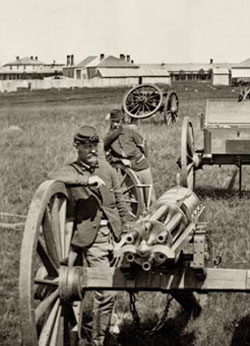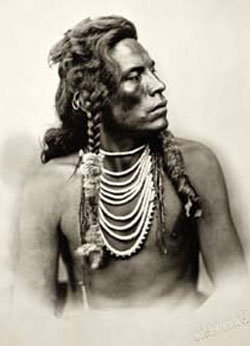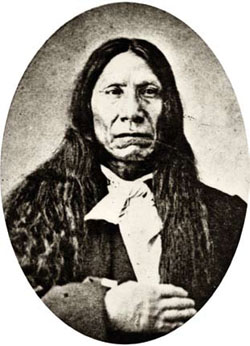Montana: Stories of the Land
Companion Website and Online Teacher's Guide
Chapter 7 - Two Worlds Collide, 1850-1887
Chapter 1 - Montana: Where the Land Writes History
Chapter 2 - People of the Dog Days
Chapter 3 - From Dog Days to Horse Warriors
Chapter 4 - Newcomers Explore the Region
Chapter 5 - Beaver, Bison, and Black Robes
Chapter 6 - Montana's Gold and Silver Boom
Chapter 7 - Two Worlds Collide
Chapter 8 - Livestock and the Open Range
Chapter 9 - Railroads Link Montana to the Nation
Chapter 10 - Politics and the Copper Kings
Chapter 11 - The Early Reservation Years
Chapter 12 - Logging in the "High Lonesome"
Chapter 13 - Homesteading This Dry Land
Chapter 14 - Towns Have Lives, Too
Chapter 15 - Progressive Montana
Chapter 16 - Montana and World War I
Chapter 17 - Montanans on the Move
Chapter 18 - The Great Depression Transforms Montana
Chapter 19 - World War II in Montana
Chapter 20 - Building a New Montana
Chapter 21 - A People's Constitution
Chapter 22 - Living in a New Montana
Educator Resources
Educational Trunks
-
Cavalry and Infantry: The U.S. Military on the Montana Frontier from the Montana Historical Society. This trunk explores the role of the U.S. military and the life of an enlisted man on Montana's frontier, 1860 to 1890.
Takeaways
-
Inspired by reading specialist Tammy Elser, who was in turn inspired by SKC graduate Taylor Crawford, we've created a "Takeaway" bookmark for every chapter of Montana: Stories of the Land. Before starting a chapter, print and cut out these bookmarks and distribute them to your students. Ask them to use the Takeaway to summarize the GIST of what they learn from reading assigned sections of the chapter. Remind them that they don't have much room, so they'll need to think before they write down the most important idea they want to take away from the section. Learn a little more about the GIST strategy.
-
Even though we've created Takeaways for every chapter, we don't recommend you have your students complete a Takeaway for every section of every chapter they read. That would be exceedingly tedious. However, used appropriately, they can be a useful tool for encouraging reflection and teaching students how to summarize information.
Websites and Online Lesson Plans
-
Who Are the Little Shell? (Designed for grades 6-8) is a large (17 day) unit that cover the history of the Anishinaabe, the McCumber Commission and the 10-Cent Treaty, Chief Little Shell, the buffalo economy and Red River carts, the Landless Indians of the twentieth century, and the fight for federal recognition. It also answers the questions “Who are the Métis” and introduces students to the Métis Archipelago. The unit can be taught in its entirety, but each subtopic can also be taught independently. Former classroom teacher Anna East and Montana current poet laureate and Little Shell tribal member Chris La Tray created the unit for the Indian Education Division of the Montana Office of Public Instruction.
-
The Annotated Resource Set Two Worlds Collide, 1850-1887, includes links to maps, documents, artwork, and photographs relating to the Treaty and Removal Period. Many, but not all, of the images were also used to illustrate Chapter 7 of Montana: Stories of the Land. These sources can be used to build PowerPoints or to create DBQs or other primary-source based activities.
-
"Blood on the Marias: Understanding Different Points of View Related to the Baker Massacre of 1870" is a flexible one- to three-day learning activity designed to challenge students to grapple with historical evidence and to better recognize the complexity of native-white encounters.
-
"Hearing Native Voices: Analyzing Differing Tribal Perspectives in the Oratory of Sitting Bull and Plenty Coups" is a flexible one- to three-day activity that focuses on excerpts from a number of speeches and addresses given by two well-known tribal leaders. Comparing and contrasting these speeches will help students recognize that great diversity existed in the way individual American Indian leaders responded to changing circumstances during the late nineteenth century.
-
"Poems for Two Voices," recommended for grades seven through twelve, is a two- to three-day lesson that uses the same documents featured in "Hearing Native Voices: Analyzing Differing Tribal Perspectives in the Oratory of Sitting Bull and Plenty Coups." After analyzing Plenty Coups' and Sitting Bull's rhetoric, student pairs will write a poem for two voices, comparing and contrasting the tribal leaders' perspectives, gaining a better understanding of Essential Understanding regarding Montana Indians #1: "There is great diversity among the twelve tribal nations of Montana in their languages, cultures, histories and governments."
-
The Treaty Trail: U.S. - Indian Treaty Councils in the Northwest" includes information on 10 treaties negotiated by Territorial Governor Isaac Stevens, including the Hellgate Treaty and the 1855 Treaty (also known as Lame Bull's Treaty). The site includes complete texts of the treaty, lesson plans, maps, and much more information.
-
Full text of the 1851 and 1868 Fort Laramie treaties are available online.
-
The Gilder Lehrman Institute has posted an interesting high school lesson plan, “June 25, 1876: An Interpretation of an Historical Event,” by Bruce Lesh. Focusing on the debate over naming the Little Bighorn Battlefield National Monument, the lesson plan asks students to analyze images, primary and secondary sources to consider how events from the Indian Wars be commemorated by the federal government. (You'll need to register for a free account to access.)
-
Federal Indian Policy-Treaty Period" is an IEFA Model lesson plan from OPI.
-
The National Archives has posted this Teaching with Documents lesson plan on the Fort Laramie Treaty of 1868.
-
The American Memory Project has put up maps that document the Indian Land Cessions from 1784-1894 (U.S. Serial Set 4015). You can browse by tribe or by state/territory.
-
Montana The Magazine of Western History created discussion guides for articles in its winter 1999 transportation issue, including "The Crow Indians and the Bozeman Trail," by Frank Rzeczkowski. They also posted the text of the article online.
-
OPI has a model IEFA lesson plan that asks students to analyze John Gast's 1872 print, American Progress (reproduced on page 132 of the textbook).
-
Explore multiple perspectives on the Battle of the Little Bighorn with OPI's IEFA model lesson plan focused on the battle: "Point of View, Misconceptions, and Errors of Omission - Perspectives on the Battle of the Little Big Horn .
-
Learn more about the Nez Perce War through this National Park Service website.
-
The "Learning Resources" produced by the Gabriel Dumont Institute of Native Studies and Applied Research offers lesson plans including "La Mishow Wayayshhaywuk: The Big Rip Off," which investigates the events leading up to the Metis Resistance (or Riel Rebellion) of 1885.
-
The National Park Service has digitized Nez Perce Summer, 1877, by Jerome A. Greene, the definitive book on the Nez Perce War.
-
As part of its unit on the Gilded Age, the Stanford History Education Group has created a primary source based lesson plan on the Battle of the Little Bighorn. The guiding question of the lesson, which asks students to analyze an American history textbook description of the battle, along with two primary source documents (J.D. Cameron, Letter to President Ulysses S. Grant, July 8, 1876 and Kate Bighead, Interview with Dr. Thomas Marquis, 1922), is "Who was responsible for the Battle of Little Bighorn?" You must register to view the lesson plan and documents, but registration is free.
-
Salish Kootenai College professor Tammy Elser created a lesson plan on reading a treaty that can be used with any treaty, and which is aligned to the C-3 Framework.
Videos or DVDs
-
The Bicycle Corps: America's Black Army on Wheels, PBS - 60 minutes.
-
The Invasion of America, eHistory.org 1.5 minutes.
-
"Fight No More Forever," Episode 6 of the PBS series The West - 84 minutes. Available for purchase via an internet search.
-
How the West Was Lost, a Discovery Channel Series (each episode is 58 minutes). Available for purchase via an internet search.
-
Sitting Bull: A Stone in My Heart, produced by Lillimar Pictures - 83 minutes.
Possible Field Trips: View the Map
-
Bear Paw National Battlefield, near Chinook
-
Big Hole National Battlefield, near Wisdom
-
Council Grove State Park, near Missoula (Related IEFA lesson plans are available.)
-
Little Bighorn Battlefield National Monument, near Hardin
-
Rosebud Battlefield State Park, near Hardin (Related IEFA lesson plans are available.)
Chapter 7 Test and Answer Keys Page
The tests and answer keys are password protected.
You can contact us to receive the password:
- Martha Kohl - call (406) 444-4790 or email mkohl@mt.gov
- Melissa Hibbard - call (406) 444-4741 or email Melissa.Hibbard@mt.gov
Or, if you used the old system, the original username is now the new password. You will be asked for this case-sensitive password every time you open a new document.
Alignment to ELA Common Core Standards
Alignment to Content Standards and Essential Understandings Regarding Montana Indians (EU)






